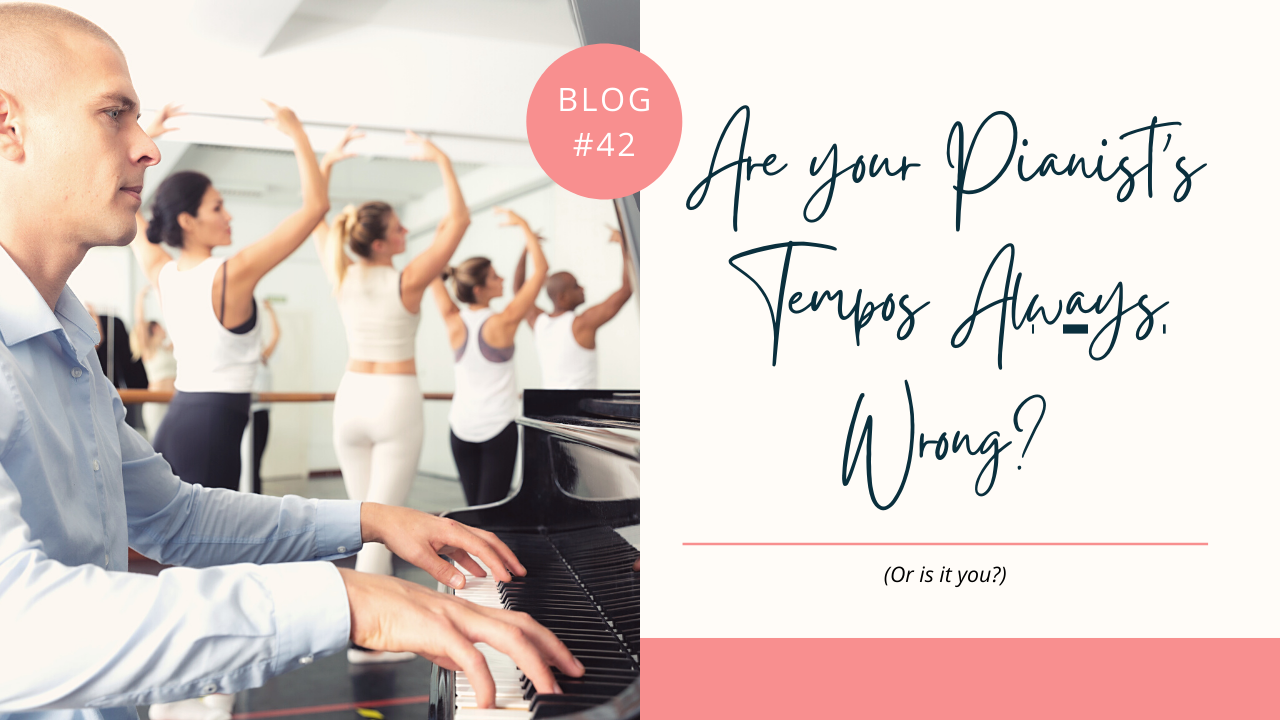
Blog #42: Are your Pianist’s tempos always wrong?
Apr 22, 2021I’m about to say some thing that might sting a little… Like salt on a wound. Ready? It comes from a place of love and understanding so please bear with me, ok?
If you’re a ballet teacher who works with pianists/musicians and your pianist's tempos are always wrong, no matter who the pianist is.. it's probably the other adult in the room. (Don't shoot the messenger just yet.. bear with me!) I promise this is going somewhere good!
To avoid having this constant tempo frustration in the studio, here is my number one recommendation..Drumroll...

What I mean is, when you're creating a tendu exercise, pick a piece of music and listen to it while you're creating that tendu exercise. Match your tendu exercise to that music in tempo, quality and phrases, even if it's not going to be the actual music for your class..
Here's why!
4 Invaluable Effects of Listening to Music When You're Creating a Class
- It ensures that all of your movements in your exercise work at the same tempo. When you don’t use music as you create your exercise, you can subtly adjust your tempo in your head and you don’t even notice doing it. Once you’re in the studio and a pianist begins playing for your exercise at your original marked tempo, suddenly it becomes very apparent that different parts of the exercise don’t work at that speed and now your pianist looks bad because the music isn’t working, it’s either too fast or too slow.. OR BOTH! Gak!
- Another reason for creating exercises with music is that it will tighten up the feel of the exercise and the purpose for that tempo. Tempos are not arbitrary, they serve a purpose in supporting the qualities of the movement and the patterns in the exercise. Listening to music as you create will bring immense clarity to the exact purpose and qualities you want from that exercise. That in turn, will help you remember the exact tempo you want when you’re marking in the studio! It’s a win-win!
- Thirdly, it will give you the qualities and musicality in your subconsciousness when you’re marking in person, in class! You will often hear that music in your head as you mark your exercise and that can dramatically improve the way you mark it and therefore the way others pick it up from you, whether dancers or pianists. (Oh yeah, even your dancers will benefit from this!)
- Finally, your exercises will become so much more musical if you create them while listening to music. Music is created in phrases, just like ballet exercises. Our music phrases are anywhere from 2 to 8 counts long. When you use music and listen to it while you create your exercises, you will consciously (or subconsciously) match the music phrasing in your movements. This is powerful because music phrasing is very consistent generally. Your exercises will naturally be musical if you create them while taking into account the music phrases that you’re hearing.
So, though this is a fairly short blog post compared to others I've written, it’s incredibly valuable if you put it into action! Your students, pianists, musicians, etc will thank you when it becomes infinitely easier to pick up your exercise and understand what you're thinking, musically!
Always listen intentionally to specific music when you are creating exercises and you’ll be amazed at how much better your exercises feel with music and how much easier it is to mark them musically in the studio (you won't be searching your brain for the tempo or meter you want as often, or at all!).
And finally, you’ll be blown away by how much better your pianist/exercise/musicality relationships will be! If you're not one of their favourite teachers to play for, you'll be well on the way there using this tip! (Really, who doesn't want to be the favourite ballet teacher in the studio, right?!)
So so so worth it!
If you're thinking, "Lorel that's great, but where do I even start with thinking about exercises and music combinations?", I suggest you grab a freebie I've created giving you some ideas for music types and ballet exercises called 10 Creative Ways to Use Music! Start with that and see where it takes you!
If you've enjoyed this blog post and others,
1) please let me know by email or a DM on IG, and,
2) PLEASE, share this far and wide in your social media. That helps me get the word out about my business without funnelling money into Zuckerberg's pocket in ads.
I would be forever grateful!
Stay connected with news and updates!
Join our mailing list to receive the latest news and updates from our team.
Don't worry, your information will not be shared.
We hate SPAM. We will never sell your information, for any reason.

